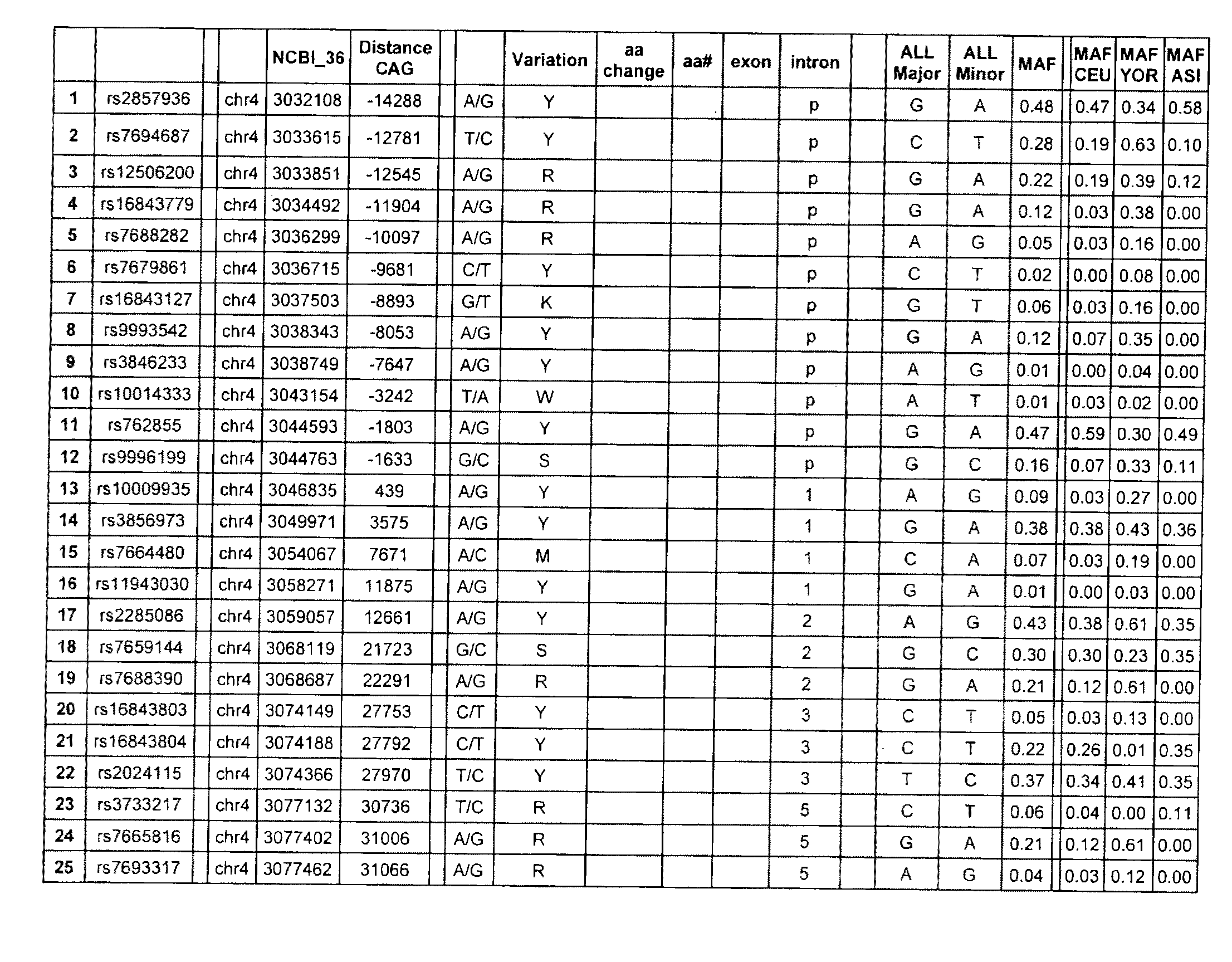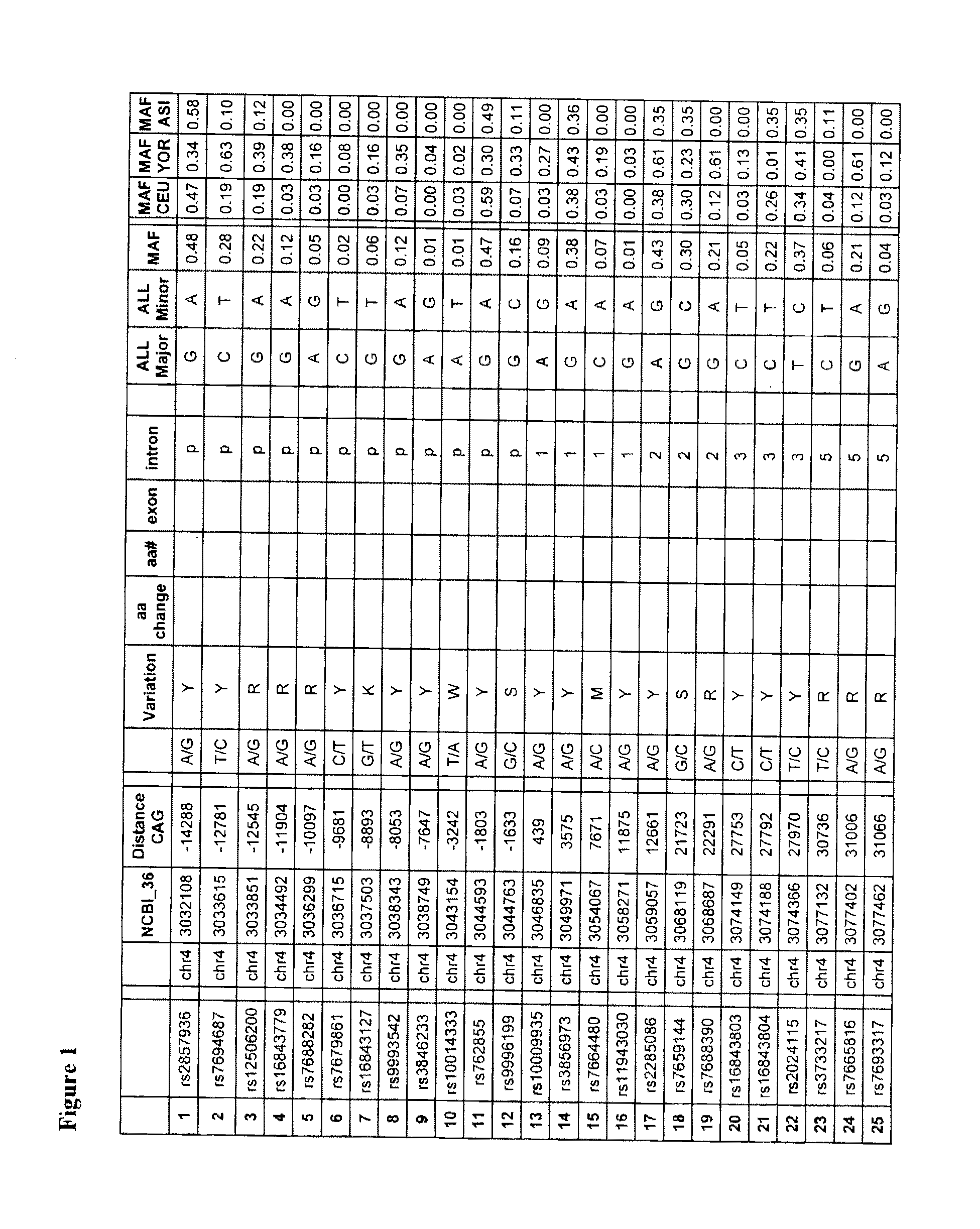Methods and compositions for the treatment of huntington's disease
a technology for huntingtons and compositions, applied in the field of methods and compositions for the treatment of huntingtons disease, can solve the problems of difficult targetting trinucleotide expansion, difficult to reduce the expression of huntingtin from the wildtype allele, and negative consequences, so as to reduce the expression of mutant huntingtin (mhtt) protein and reduce the expression of mutant huntingtin (mhtt protein)
- Summary
- Abstract
- Description
- Claims
- Application Information
AI Technical Summary
Problems solved by technology
Method used
Image
Examples
example 1
Identification of Target SNPs
[0137]SNPs were identified using preliminary sequencing of the Hapmap cohort, and information available from the dbSNP database maintained by the National Centre for Biotechnology Information (Sherry et al. Nucleic Acids Res. 2001 Jan. 1; 29(1):308-11 URL: ncbi.nlm.nih.gov / projects / SNP / ). Sequence data at the 190 SNP positions (FIG. 1) was obtained from sequencing of the Hapmap population (Gibbs et al., 2003. Nature 426 789-796 (URL: hapmap.org / ) conducted at the McGill / Genome Quebec Innovation Centre. Nucleic acid samples from 65 Huntington's disease-affected subjects were genotyped for these SNPs, each subject having a mutant and normal chromosome. Phasing of the polymorphisms (which allele is associated with the normal and mutant chromosomes) in the 65 HD subjects was established using genotyping information obtained from mother-father-child trios, or was computed using statistical algorithms using software such as PHASEv2.1 (Marchini J et al 2006. Am...
example 2
Identification Differentiating Polymorphisms—Target SNPs
[0142]Candidate target SNPs were identified by comparison of the frequency distribution, by chi-square and odds ratio, in CAG-expanded chromosomes vs control chromosomes within the 65 HD patient cohort. Target-candidate tSNPs were selected based on the selective enrichment of one allele on CAG-expanded alleles (as evidenced by an Odd ratio (OR)>3) (Table 7) and a degree of high heterozygosity in HD patients (Table 8). tSNPs with a significant p-value (alpha=0.00025 after bonnferroni correction) are observed for tSNPS 1, 11, 14, 22, 65, 89, 97, 119, 178, 182 and 190; indicating that the distribution of the alleles are significantly different between the mutant and wild-type HD chromosomes. The phased allelic analysis of the 65 HD patients is also shown in Table 8. Additional SNPs exhibiting a correlation (r2<0.5) with the tSNPs were also identified as targets. A total of 67 SNPs were therefore considered as target SNPs due to st...
example 3
SNP Frequency Distribution on HD Chromosomes
[0143]Using the patterns of linkage disequilibrium in the 190 validated SNPs, a panel of 22 non redundant tagging SNPS (tSNPs) was designed to efficiently assess genotypes and construct haplotypes in the HTT gene region. In order to determine which genotypes came from each chromosome within each individual, chromosomes were phased by CAG-tract size. This allowed grouping of chromosomes by CAG-tract size, and comparison of genotypes between the groups. HD patients (n=65) of European ancestry were genotyped at the 22 tSNP positions. Genotype information for disease chromosomes (>35 CAG) and control chromosomes (<36 CAG) from these HD patients is shown in FIG. 2A. Allele counts for the major (A) and minor (B) alleles are given at each of the 22 tSNP positions.
[0144]HD chromosomes demonstrated a dramatically different allele distribution compared to control chromosomes. Of the 22 tSNPs, over half (12 SNPs) were significantly associated with di...
PUM
| Property | Measurement | Unit |
|---|---|---|
| temperature | aaaaa | aaaaa |
| temperature | aaaaa | aaaaa |
| temperature | aaaaa | aaaaa |
Abstract
Description
Claims
Application Information
 Login to View More
Login to View More - R&D
- Intellectual Property
- Life Sciences
- Materials
- Tech Scout
- Unparalleled Data Quality
- Higher Quality Content
- 60% Fewer Hallucinations
Browse by: Latest US Patents, China's latest patents, Technical Efficacy Thesaurus, Application Domain, Technology Topic, Popular Technical Reports.
© 2025 PatSnap. All rights reserved.Legal|Privacy policy|Modern Slavery Act Transparency Statement|Sitemap|About US| Contact US: help@patsnap.com



